|
|
|
Sort Order |
|
|
|
Items / Page
|
|
|
|
|
|
|
| Srl | Item |
| 1 |
ID:
092926


|
|
|
|
|
| Publication |
2009.
|
| Summary/Abstract |
Since 2003, a series of Six-Party Talks has attempted to halt North Korea's nuclear development; nonetheless, considering the development of North Korean nuclear capability, the talks are often regarded as an ineffective framework. In order to break through such a situation, first and foremost it is imperative to understand the nature of North Korean foreign policy. In this paper, I argue that North Korean foreign policy can be explained by neoclassical realism: the international distribution of power is interpreted by its domestic political system based on the self-reliance (Juche) ideology and the supreme leader (Suryong) political structure, whose basis is its Confucian culture, and I argue that this perception has predominantly determined its foreign policy decision-making.
|
|
|
|
|
|
|
|
|
|
|
|
|
|
|
|
| 2 |
ID:
158258
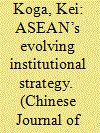

|
|
|
|
|
| Summary/Abstract |
This article argues that a change in institutional strategy enables The Association of Southeast Asian Nations (ASEAN) to manage its great power relations and prevent their abrupt political intrusion into the region by providing the policy options of pursuing institutional balancing, bandwagoning, hedging, or co-option. ASEAN’s strategy is not only to choose optimal policy under a changing security environment, but also to create an institutional division of labour by proliferating ASEAN-led institutions to ensure, as far as possible, regional autonomy and Member States’ security. Changes in ASEAN’s institutional strategy occur when its Member States expect a change in the regional distribution of power. However, due to constraints created by the existing institutional design it is difficult to make any drastic alteration to the institutional strategy unless a radical change in the regional power configuration occurs. This article examines the cases of East Asia Summit and ASEAN Defence Ministers Meeting (ADMM)/ADMM-Plus during the period 2005–2016, the comparison of which illuminates the causes and processes of their strategy change and helps to deepen our understanding of the roles of regional security institutions.
|
|
|
|
|
|
|
|
|
|
|
|
|
|
|
|
| 3 |
ID:
163754
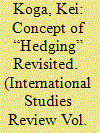

|
|
|
|
|
| Summary/Abstract |
This article argues that the concept of “hedging” should be understood in the context of the “balancing-bandwagoning” spectrum within the “balance of power” theory, in which hedging is located between balancing and bandwagoning as the state's third strategic choice. Although polarity— unipolar, bipolar, and multipolar—largely determines the likelihood of hedging behavior, during a period of power shift, strategic uncertainty emerges. States, particularly secondary powers, attempt to calculate the risk of balancing, bandwagoning, and hedging, adopting an optimal strategy. To identify states’ strategic behavior, it is important to first examine their economic and military capabilities, and if these indicators are not decisive enough to identify balancing, bandwagoning, or hedging behavior, diplomatic factors should be taken into account, although those are a relatively weaker indicator.
The use of this conceptual framework reveals that Japan's foreign policy behavior has not involved “hedging” vis-à-vis China; instead, Japan's behavior is consistently associated with “balancing” against the risks of China's rise. In addition, while Japan's behavior vis-à-vis the United States is considered to be bandwagoning, Japan made political efforts to strengthen its own military capabilities—internal balancing—which began in the 2010s when Japan relaxed its political constraints on use of its military. This behavior also aimed both to illustrate Japan's efforts related to alliance burden-sharing and to enhance its external balancing with the United States. Yet, the periods from 1997 to 2005 and from 2010 on represent an aberration because Japan engaged one type of hedging—security hedging—vis-à-vis the risk of US commitment reduction to East Asia. In this sense, while concurring with the realists’ argument that Japan's current behavior is characterized as balancing, the argument differs from that of realists who believe that Japan's policy shift to balancing toward China only began with China's rise in the late 2000s or 2010s.
|
|
|
|
|
|
|
|
|
|
|
|
|
|
|
|
| 4 |
ID:
177611
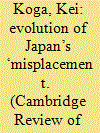

|
|
|
|
|
| Summary/Abstract |
This article argues that since the Meiji Restoration, the degree of Japan’s misplacement has changed, depending on its structural power and ability to shape the concept of ‘Asia’ as a region. More specifically, there are three historical turning points: first, from the Meiji Restoration to the Pacific War (hard misplacement); second, post-World War II to the end of the Cold War (soft misplacement); and third, post-Cold War to the present (relative well-placement). In each period, Japan was faced with a different concept of ‘Asia’ and attempted to modify its identity and roles accordingly. The degree of ’misplacement’ is thus not static, but elastic, and such a status is not a permanent attribute of the state. Changes occur when states undertake a role location process, particularly during or after a change in the regional environment.
|
|
|
|
|
|
|
|
|
|
|
|
|
|
|
|
| 5 |
ID:
190370
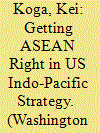

|
|
|
|
|
| Summary/Abstract |
As part of the intensifying great power competition between the United States and China, a set of new Indo-Pacific frameworks primarily led by Washington—namely the Quadrilateral Security Dialogue (Quad), the AUKUS, and the Indo-Pacific Economic Framework for Prosperity (IPEF)—has emerged. These US-centric minilateral and multilateral frameworks essentially aim to build a coalition with politically and strategically “like-minded” states to maintain and enhance the existing rules-based international order largely constructed by the West since the end of the Cold War.
|
|
|
|
|
|
|
|
|
|
|
|
|
|
|
|
| 6 |
ID:
188206
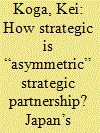

|
|
|
|
|
| Summary/Abstract |
I argue that the asymmetric strategic partnership (ASP) between a regional great power and a small power is not necessarily based on their shared goals, but such a partnership would help them achieve their own strategic objectives. For a regional great power, an ASP helps prevent a weak partner from excessively depending on a rival state for its economy and security. For a small power, the partnership increases the legitimacy of domestic political regime while offering a strategic option to hedge against the risk of over-dependence on a particular state by diversifying political and economic assistance. In short, ASPs serve as a wedge strategy for a regional great power, while it functions as a hedging strategy for a smaller power. I apply this conceptual framework to analyze two cases, the Japan-Cambodia and Japan-Laos strategic partnerships.
|
|
|
|
|
|
|
|
|
|
|
|
|
|
|
|
| 7 |
ID:
174738
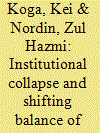

|
|
|
|
|
| Summary/Abstract |
This article examines the causal process of the institutional collapse of the Asia Pacific Council (ASPAC) in 1973 by focusing on Malaysia’s foreign policy behavior, and highlights implications for today’s ASEAN. Specifically, it argues that the institutional collapse of ASPAC was caused by Malaysia’s withdrawal, which stemmed from a shift in its balance of ontological security from security dependence on the UK and the West to greater political autonomy in Southeast Asia. This occurred after a change in the regional distribution of power caused by the UKs withdrawal from East of Suez, and to a lesser extent, US disengagement from Southeast Asia. In the 1960s and 1970s, Malaysia demonstrated the conflicting duality of ontological security, consisting of strategic and aspirational identities. Malaysia’s strategic identity was its association with the West, particularly the UK, which was nurtured through Malaysia’s routinized strategic interaction with them in the security realm. This identity prevented Malaysia from easily or completely abandoning its security ties with them, even when the strategic benefit was significantly marginal. On the other hand, Malaysia’s aspirational identity was to attain greater political autonomy without external interventions, particularly from great powers, which Malaysia experienced during its colonial period. Such sentiments emerged at the end of World War II and the following decolonization process, and were partly illustrated by Malaysia’s pursuit of the non-aligned movement.
|
|
|
|
|
|
|
|
|
|
|
|
|
|
|
|
| 8 |
ID:
190072
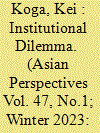

|
|
|
|
|
| Summary/Abstract |
How is the future of the Indo-Pacific institutional arrangements envisioned by the Quad and ASEAN? Are they mutually exclusive or compatible? How can the institutional competition between the Quad and ASEAN in the Indo-Pacific be avoided? I argue that the institutional competition between the Quad and ASEAN can be provisionally alleviated through strategic ambiguities about the institutional division of labor in the Indo-Pacific. However, such strategic ambiguities do not resolve normative inconsistencies between the Quad and ASEAN, which would probably trigger institutional competition in the future. To resolve such difficulties, both the Quad and ASEAN need to create a mechanism that clarifies their regional institutional division of labor.
|
|
|
|
|
|
|
|
|
|
|
|
|
|
|
|
| 9 |
ID:
135084


|
|
|
|
|
| Summary/Abstract |
Many international relations (IR) scholars discuss whether the Association of Southeast Asian Nations (ASEAN) possesses institutional utility in maintaining security in Southeast Asia or East Asia. While this has important implications for both academics and policy-makers, ASEAN's role has been too often evaluated in terms of what has persisted within the association rather than what changed. Yet, exploring the causes and processes of institutional transformation are particularly important because they have made ASEAN expand its security utility by creating security dialogues and fostering security cooperation in the region. In this context, the crucial question is: when and how has ASEAN changed?
Focusing on the causes and processes of institutional transformation which have occurred within ASEAN, this article explores ASEAN's transformation from 1968 to 1976, by using a theoretical model, developed from historical institutionalism and the punctuated equilibrium model. Applying this approach to institutional transformation of ASEAN in the political-security field, three transformation processes are constructed. First, ASEAN member states’ expected changes in the external security environment triggered internal discussions regarding ASEAN's political-security function; second, these internal political discussions fostered institutional consolidation of ASEAN during this period; and third, such direction of institutional transformation was fundamentally guided by ideas provided by institutional norm entrepreneurs (INEs), especially Malaysia's neutrality proposal.
In particular, this article examines the process of ASEAN's creation of the Zone of Peace, Freedom, and Neutrality (ZOPFAN) in 1971, and the Treaty of Amity and Cooperation (TAC) and the Bali Concord in 1976, and argues that this model shed light on the significance of ZOPFAN that created a foundation of TAC and the Bali Concord, for which conventional wisdom has dismissed as an insignificant institutional concept by academics and practitioners.
|
|
|
|
|
|
|
|
|
|
|
|
|
|
|
|
| 10 |
ID:
160370
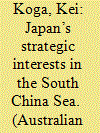

|
|
|
|
|
| Summary/Abstract |
Japan has a national interest in the South China Sea issue. Although its direct commitment is ultimately limited in a material sense due to a lack of military capabilities, as well as political and constitutional constraints on the Self-Defense Force, Japan has maintained its firm stance to uphold international maritime rules and norms, and nurtured strong diplomatic relations and conducted maritime capacity-building programs with the South-East Asian states, as well as the Association of Southeast Asian Nations. These actions contribute to consolidating the rule of law at sea and provide those claimant states an opportunity to withstand pressures from China. Given the Trump administration’s unclear South China Sea policy and South-East Asia’s strategic uncertainty, Japan is becoming a key player in maintaining regional maritime stability in East Asia through diplomacy.
|
|
|
|
|
|
|
|
|
|
|
|
|
|
|
|
| 11 |
ID:
176238
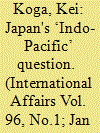

|
|
|
|
|
| Summary/Abstract |
Japan's primary objective of the ‘free and open Indo-Pacific’ (FOIP) strategy is to shape and consolidate regional order in the Indo-Pacific region based on the existing rules-based international order. The concept initially aimed to achieve two different objectives—shaping a regional order in the Indo-Pacific and ensuring the defence of Japan; however, Japan has gradually shifted its strategic focus onto the former, separating national defence from the FOIP concept, which reflects a change in the degree of its commitment to the two objectives. On the one hand, as its overall security strategy, Japan has determined to steadily enhance its national defence by increasing its own defence capabilities and strengthening the US–Japan alliance, while transforming its partnerships with like-minded states, such as Australia and India, into a diplomatic, and potentially military, alignment. This has been brought about by shifts in the regional balance of power, particularly the rise of China and the relative decline of the United States. On the other hand, as part of its FOIP strategy, Japan's attempts to build a new regional order in the Indo-Pacific region aim to defend the existing rules-based order established by the United States from challengers, particularly China. Yet, given the strategic uncertainty over Japan's international coalition-building efforts to create a new regional order, Japan has made its approach flexible; Tokyo is using its ambiguous FOIP concept to gauge other states' responses, understand their perspectives, and change its strategic emphases accordingly—so-called ‘tactical hedging’. Japan has pursued similar means to achieve the two key objectives. Nevertheless, the country's core interest, the defence of Japan, is more imperative than building a regional order in the Indo-Pacific region, and Japan faces different types of challenges in the future.
|
|
|
|
|
|
|
|
|
|
|
|
|
|
|
|
| 12 |
ID:
147609
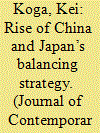

|
|
|
|
|
| Summary/Abstract |
This article argues that as opposed to the conventional wisdom of Japan’s hedging policy, Japan has been constantly taking balancing behavior vis-à-vis China since the end of the Cold War; however, the incremental shift to explicit balancing began after the 2010 Senkaku Boat Collision Incident. The shift was accelerated by the 2012 Japanese Government Purchase of the Senkaku Islands. Since then, Japan has attempted to engage in both internal and external balancing by taking more security burden-sharing with the United States through the relaxation of Japan’s constitutional and political constraints on its military capabilities and the enhancement of security linkages with other regional states, such as Australia and India.
|
|
|
|
|
|
|
|
|
|
|
|
|
|
|
|
| 13 |
ID:
144904
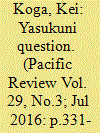

|
|
|
|
|
| Summary/Abstract |
This article argues that the problem of the Yasukuni Shrine between Japan and South Korea stems from the differential growth of Yasukuni discourses in both countries after the Pacific War. While the Japanese post-war discourse split into three schools of thought – Nationalists, Moderates, and Progressives – South Korean discourse has been consolidated into one dominant anti-Yasukuni perspective, largely shaped by Japan's political discourse and actions from the 1980s. This divergence created the perception gap between the two, resulting in a diplomatic obstacle that hinders Japan--South Korea strategic cooperation.
|
|
|
|
|
|
|
|
|
|
|
|
|
|
|
|
|
|
|
|
|